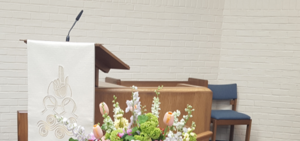
Reading the Gospel of Mark 5:21-43
“…he took her by the hand and said to her, ‘Talitha cum’…”
This passage from Mark 5:21-43 is included in the revised common lectionary provided by the Vanderbilt Divinity Library. The text is from the NRSV. You can hear a recording of this passage here.
Reading the Gospel aloud invites the audience to experience human encounters with the divine as revealed in the Bible. We can leave interpretation and meaning to members of the clergy and other scholars. What we are most interested in as lay readers is the human experience found in the narrative.
First Impressions
“She had heard about Jesus, and came up behind him in the crowd and touched his cloak…”
This passage continues the recounting of extraordinary events. Further evidence is offered that Jesus is no ordinary man. He has access to extraordinary power.
The events recounted here – of healing and lives renewed are intensely physical. They involve touching, sensing and feeling. People are suffering or are the victims of infirmity. Their bodies are broken. Jesus is administering to their physical beings.
Jesus is an active agent in their physical world, causing extraordinary things to happen; to happen quickly. These are not mystical or magical events, there are no claps of thunder and flashes of alien light. These are force majeure events. They are disruptions in our understanding of how the laws of physics work in our space and time. Jesus demonstrates how the power of faith is not constricted and limited by our understanding of these laws and how faith has a direct relationship to and effect on the health of the body. Faith triumphs over suffering, disability and our understanding of death. Faith, and the simple laying on of hands – the physical touch — and food: “give her something to eat.” These are not miracles in the sense of the impossible. These acts are demonstrated to be possible for those with faith.
What’s important in this passage is what Jesus is doing, even more than what he is saying. His physical engagement attracts the attention of the crowd. The crowd follows closely and presses in to see; to be a part of this experience. So, there is the juxtaposition of the public and the private: private encounters in public spaces.
We are witness to Jesus’ encounters with the powerless and experience the power of faith.
Text Analysis
This passage is action oriented. Jairus falls at the feet of Jesus, begging him. The crowd presses in. The woman comes forward with fear and trembling. People are weeping and wailing.
The role of women in this passage can’t be ignored or discounted. The words “Little Daughter”, “Daughter”, “little girl…” recur. Jairus, on of the leaders of the synagogue is powerless to help his daughter. He prostrates himself in front of Jesus and begs for his help.
But Jesus is about to demonstrate how the least of us in the world, in this case women and daughters have the power and ability to heal and help themselves. Women and our daughters become the leaders in accepting and embracing the power of faith.
Faith is mixed with physical action. Reaching out and touching. The taking of hands. In modern medicine, pharma and the surgeon’s knife have eclipsed the human touch and faith, ”She had endured much under many physicians…” But all three are required for true and complete healing.
We may think of the Bible as humorless. But humor and incredulity to the point of laughter is an important element in this reading. The passage is full of nervous, even giddy laughter. What’s going on here? How can these things be? “How can you say, “who touched me?” “They laughed at him…”
The disbelief of the crowd is counterpointed by the intense faith of the healer and the healed. Laughter is mixed with and transforms into amazement.
Reading this passage aloud
The reading of this passage should move quickly. There is palpable excitement in the crowd and crowd scenes. This is a movement taking shape.
Jesus responds decisively to those importuning him, but tenderly to those who require healing. He is addressing “daughters.” He has two voices.
He does not grab or hold or lift. He touches and takes by the hand. There is a lightness in the application of power and likely too in his voice.
There is much dialogue. Many voices are heard. This is human engagement. These are not solemn ritualistic acts but rather direct human contact with voice and touch: real-time human engagement and experience. The action is happening all around you as the reader. Your voice should move.
The reading crescendos in amazement as the little girls walks but ends with the most mundane of human experiences; give her something to eat.
The reader should allow the listeners to feel as though they were there.
What do you hear in this Gospel passage?

